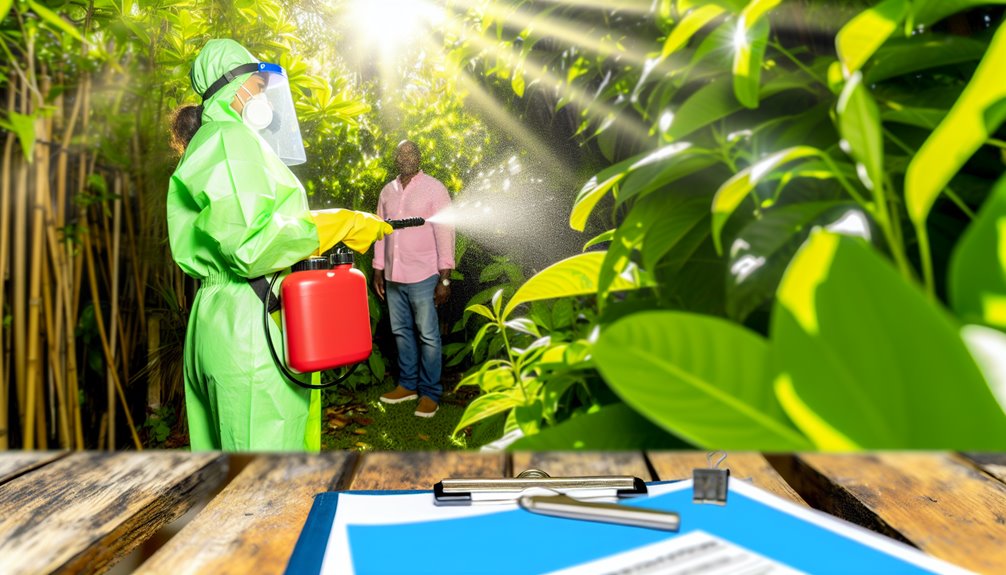You probably don’t know that a validated 70–90% mosquito reduction in 48 hours hinges on species-specific behavior and life-stage targeting, not just spray strength. You’ll see rapid adult knockdown from residual pyrethroids and IGRs, quantified by landing rate counts and trap captures. But efficacy shifts with weather, cryptic breeding sites, and oviposition cycles. If you’re timing interventions to the gonotrophic cycle and larval habitats, short-term suppression can reset population dynamics—if you act now.
What the 48-Hour Mosquito Reduction Promise Really Delivers

Although marketing language can blur expectations, the 48-hour mosquito reduction promise typically commits to a quantifiable knockdown of adult mosquito activity—often 70–90%—within two days of treatment, verified by landing rate counts or trap captures. You should interpret this as short-term suppression of host-seeking adults, not habitat eradication. Results depend on mosquito biology: species composition (Aedes vs. Culex), gonotrophic cycle timing, and resting behavior. Treatment methods target adult resting sites and flight corridors, with label-driven dosages and reentry intervals. You’ll still monitor larval sources and adjacent refugia, since reinvasion occurs. Document outcomes with standardized counts, consistent transects, and meteorological notes.
How Fast-Acting Treatments Knock Down Adult Mosquitoes
Because adulticides act on neurophysiology and behavior, fast-acting treatments rapidly suppress host-seeking mosquitoes by delivering lethal or sublethal doses on contact. You target Aedes, Culex, and Anopheles adults at resting and flight surfaces, achieving instant relief while maintaining public-facing care. Formulations with pyrethroids or neonicotinoids disrupt voltage-gated sodium channels or nicotinic receptors, inducing knockdown and mortality. Synergists like PBO mitigate metabolic resistance, improving outcomes. You deploy calibrated droplet sizes for ideal impingement on tarsi and antennal sensilla.
1) Match active ingredients to local species composition.
2) Validate knockdown via 30-minute bioassays.
3) Rotate modes of action for durable, effective solutions.
Timing the Life Cycle: Why Two Days Can Change the Trajectory

When you align interventions with mosquito cohort age structure, two days can shift population dynamics by orders of magnitude. You act before Anopheles, Aedes, or Culex females oviposit again, intercepting the mosquito lifecycle at high-leverage stages. That’s the timing importance: target pupae before eclosion and nulliparous adults before first blood meal.
Variables That Influence Results: Weather, Water, and Yard Conditions
Even minor shifts in weather, water availability, and yard structure recalibrate mosquito population dynamics and intervention efficacy. You’ll see rapid reductions when you track weather patterns that modulate temperature, humidity, and wind, because these variables alter flight, host-seeking, and larval development rates. Water governs oviposition: transient puddles, clogged gutters, and irrigation overspray can convert subcritical habitats into productive sites. Yard maintenance shapes refugia; dense understory, leaf litter, and shaded structures preserve moisture and harbor adults.
1) Prioritize hydrology audits: map containers, drains, and low spots.
2) Align applications with fronts and diurnal wind minima.
3) Prune, dethatch, and declutter to reduce shaded resting niches.
Prep, Partnering, and Maintenance to Extend Your Results

Two practices extend control: pre-treatment preparation and post-treatment maintenance coordinated with partners. You’ll optimize the 48-hour window by applying prep strategies: empty containers (>7 days water), scrub biofilm in birdbaths, bag leaves, elevate tarps, trim understory to expose resting sites, and schedule service before forecasted precipitation. Coordinate with neighbors and municipal vector teams to align larval habitat reduction across property edges.
After treatment, use maintenance tips: refresh water features every 3 days, maintain gutters, aerate ponds, repair screens, and document adult activity by time and microhabitat. Reapply larvicides where legal. Validate outcomes with landing-rate counts and adjust intervals seasonally.
Conclusion
As the proud owner of Mosquito Eliminators of South MS, I want to personally invite you to take the first step towards enjoying your outdoor spaces again. With our 48-hour mosquito reduction promise, you can trust that we’re here to help you reclaim your yard from those pesky pests. We’re passionate about providing you with a solution that works, and we’re just a call away at (601) 336-2277. I encourage you to visit our website at mosquitoeliminatorsms.com to learn more about our services and how we can assist you. Together, let’s make your outdoor experience as enjoyable as it should be!

